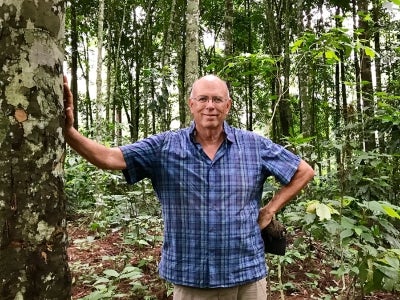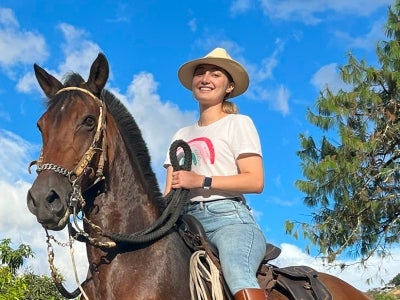
Martha Cuba de Cronkleton speaking at a knowledge sharing event on sustainable agriculture in Peru’s Andean highlands.
Martha Cuba de Cronkleton is head of international affairs and cooperation at Peru’s Ministry of Environment and serves as her country’s GEF Operational Focal Point. In an interview, she reflected on the ways the Global Environment Facility has helped Peru advance its environmental priorities and build new coalitions for enduring support.
What are Peru’s main environmental priorities?
One important priority is climate change. In 2018, Peru passed a framework law on climate change that deals with things like increasing carbon capture, reforestation, promoting renewable energies and cleaner transportation systems, and solid waste management. It was the first Latin American climate change framework law to incorporate responsibilities from the Paris Agreement, and hopefully will enable Peru to contribute to global solutions.
Conservation and the sustainable use of biodiversity and ecosystem services are also important to us because we are a mega-diverse country with the second-largest area in the Amazon Basin. Although the situation in Peru has improved in recent years, deforestation is still a big challenge with negative impacts on the livelihoods of local people, especially Indigenous communities. We are focused on creating sustainable livelihoods that value the forests and make sound use of the goods and services that the forests produce.
Finally, we are promoting a transition towards a circular economy, which entails a change in the model of consumption and production, prevents the irresponsible use of natural resources, and reduces waste and emissions, while still advancing economic development. Without a doubt, a milestone was the inclusion of the circular economy model as one of the objectives of our National Competitiveness and Productivity Policy.
How has the GEF helped Peru advance its environmental agenda?
Support from the GEF has been extremely important to us. In fact, it predates the creation of our Ministry of Environment. One of the most important things we have done with the GEF is laying the foundation for the effective management of our national system of protected areas. This project included promoting the long-term financial sustainability of protected areas and building institutional capacity. That wouldn’t have been possible without the GEF’s support.
Additionally, several GEF projects related to shared marine and freshwater ecosystems have allowed us to establish fruitful relationships with neighboring countries to manage, restore, and sustain important resources. This includes the Humboldt Current, which flows along the coasts of Chile and Peru and has some of the largest fish populations in the world, and Lake Titicaca, a cornerstone of the Andean identity, situated between Peru and Bolivia.
Also, Peru belongs to the Amazon Sustainable Landscapes program, a GEF-funded initiative managed by the World Bank. This initiative has allowed us to work with other countries in the region, to discuss important topics including forest management, and to create a common vision for what we can do together in the Amazon biome.
 Martha Cuba de Cronkleton, GEF's Operational Focal Point for Peru, with community members and local officials at a knowledge sharing event in Peru’s Andean highlands
Martha Cuba de Cronkleton, GEF's Operational Focal Point for Peru, with community members and local officials at a knowledge sharing event in Peru’s Andean highlands
Is there a GEF-supported project that is close to your heart?
There is a project supporting agro-biodiversity in the Peruvian Andes that I love because it is helping small producers in the highlands improve their livelihoods and value their unique culture and heritage. It’s about working with Indigenous communities to preserve traditional ways of farming; to manage forests, water, and land resources; and to maintain ecosystem services. This project seeks to recover traditional, ancestral knowledge and to increase access to markets for goods and services produced using those sustainable, ancient practices.
What life lessons has your work life taught you?
For me, the most important lesson is that you have to put people first. It’s always about cultivating the human side of things and trying to listen to what the other person is saying. We have to learn to work with other ministries, understanding that the environment is a cross-cutting issue. I used to think negotiation was all about talking and having my point of view accepted. Now I have made it a point to listen closely to others because I have learned that all people need to tell their story. In the end, having these human connections and engaging in a meaningful way with many different stakeholders is what allows you to move forward.
What environmental initiatives are you most optimistic about?
If COVID has taught us anything, it’s that we have a very dysfunctional relationship with nature. It’s our duty and responsibility to care for the environment and one way of doing that is through marine protected areas. There is a perception that when you create protected areas, you transform those landscapes or seascapes into unproductive spaces and condemn local communities to poverty. That is wrong. We can conserve and also grow at the same time.
One important initiative that is being discussed in Peru is related to the Tropical Sea of Grau, known in Spanish as the Mar de Grau, in northern Peru. My dream is for the Peruvian government to formally designate it as a marine protected area. This would help us conserve our amazing marine diversity.
Another dream is to have a full-fledged circular economy. We all want to have a more prosperous and also sustainable country that doesn’t deplete its resources and that thinks about the next generation. That would be a major change.


